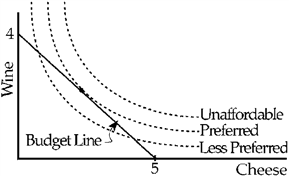Alice has $10 to spend on wine and cheese. If wine is $2.50 a glass and cheese $2, draw the corresponding budget line. Then draw three indifference curves, one showing the amount of wine and cheese Alice would choose, one showing less preferred combinations of wine and cheese, and the last showing preferred but unaffordable combinations
See Figure 5-22, below.
Figure 5-22

You might also like to view...
Apple introduced its iPhone 3G in July 2008 and within a month sales had topped 3 million units. By April 2009, more than 25,000 apps for the iPhone 3G were available in the iTunes store, an indication that in a competitive market
A) entry into the market is restricted in the short run, but becomes easier in the long run. B) the ease at which a new firm can enter a competitive market is high. C) entry into the market is blocked. D) the ease at which a new firm can enter a competitive market is low.
There are 1,000 identical firms in a price-taker industry. In the short run, total revenues of each firm exceed total costs. What will happen in the long run?
a. Nothing, because each firm is already maximizing its profits. b. Many firms will enter the market and each firm will eventually operate at a loss. c. Additional firms will enter the market, and price will be driven down to where each firm will be making just enough to stay in business. d. Additional firms will enter the market, but the price will remain the same because the existing firms will not allow price to decrease.
If an economy produces 5,000 units of output with a price level of $1 and with a velocity of money of 4, we know that the money supply must be:
A. $5,000. B. $4,000. C. $2,500. D. $1,250.
A decrease in supply will occur when
A. the supply curve shifts upward to the left. B. the supply curve shifts downward to the right. C. the demand curve shifts downward to the left. D. the demand curve shifts upward to the right.